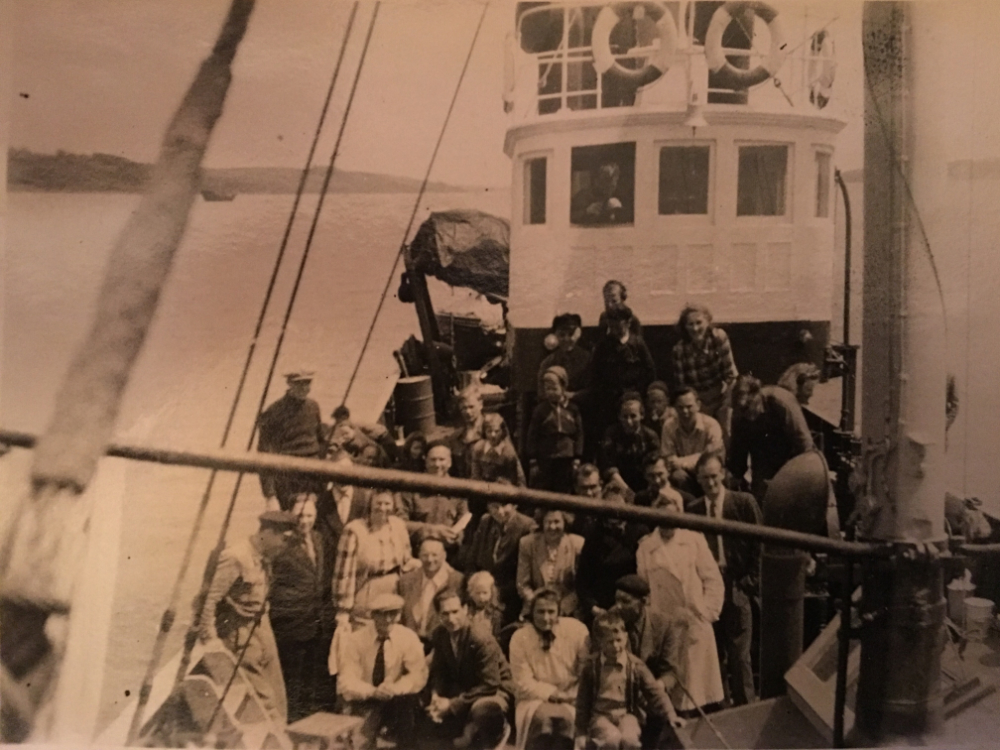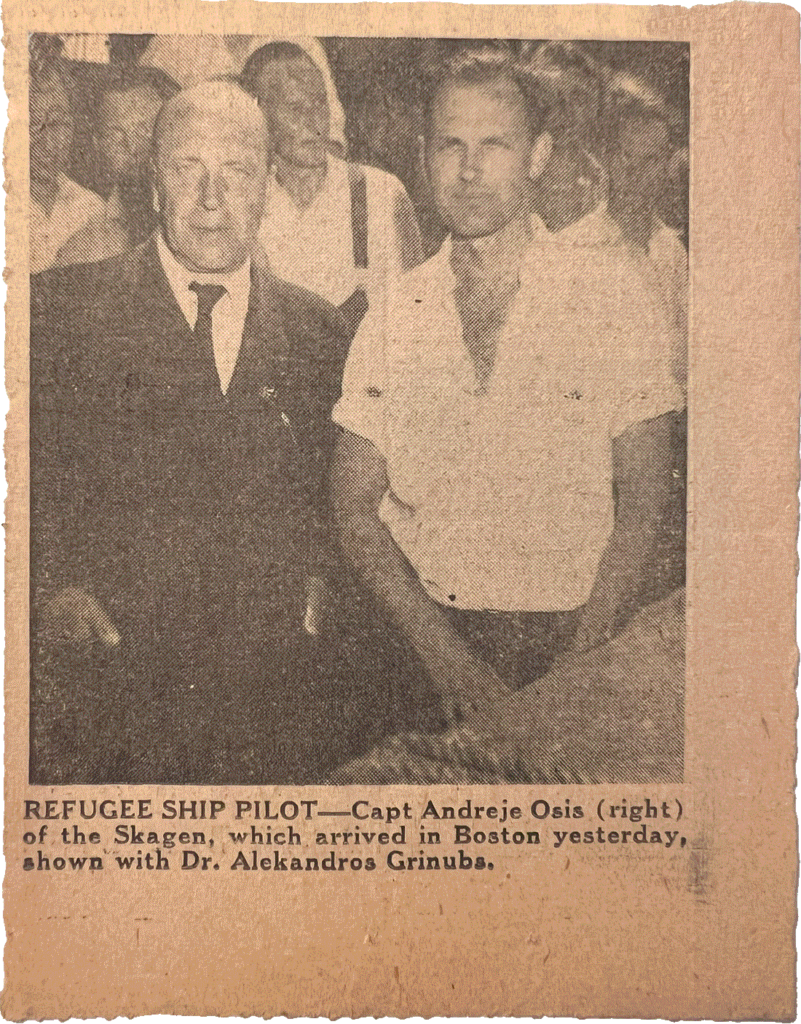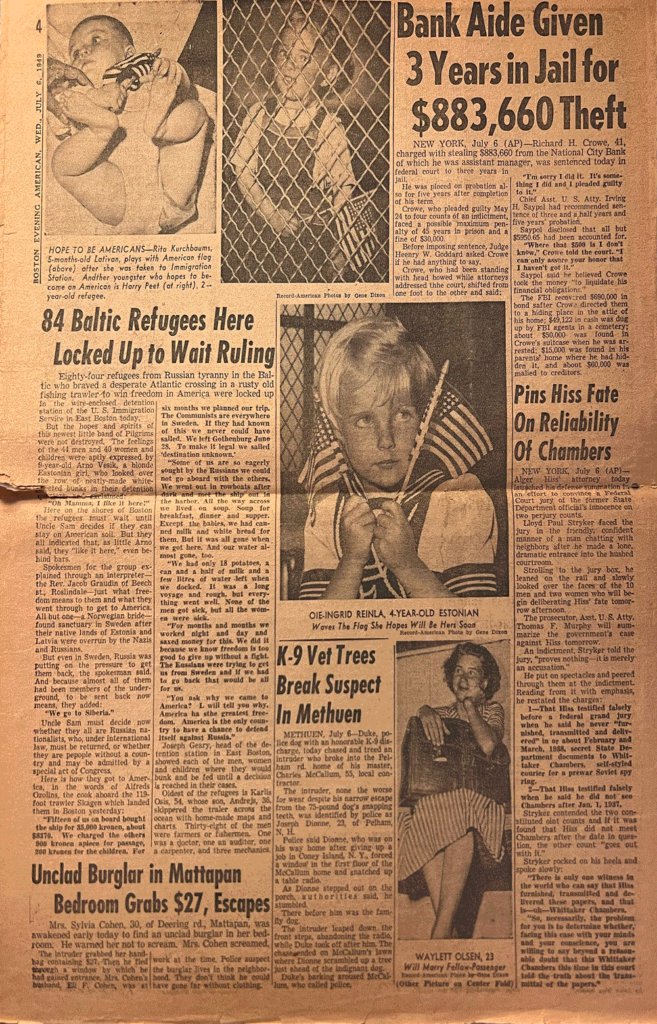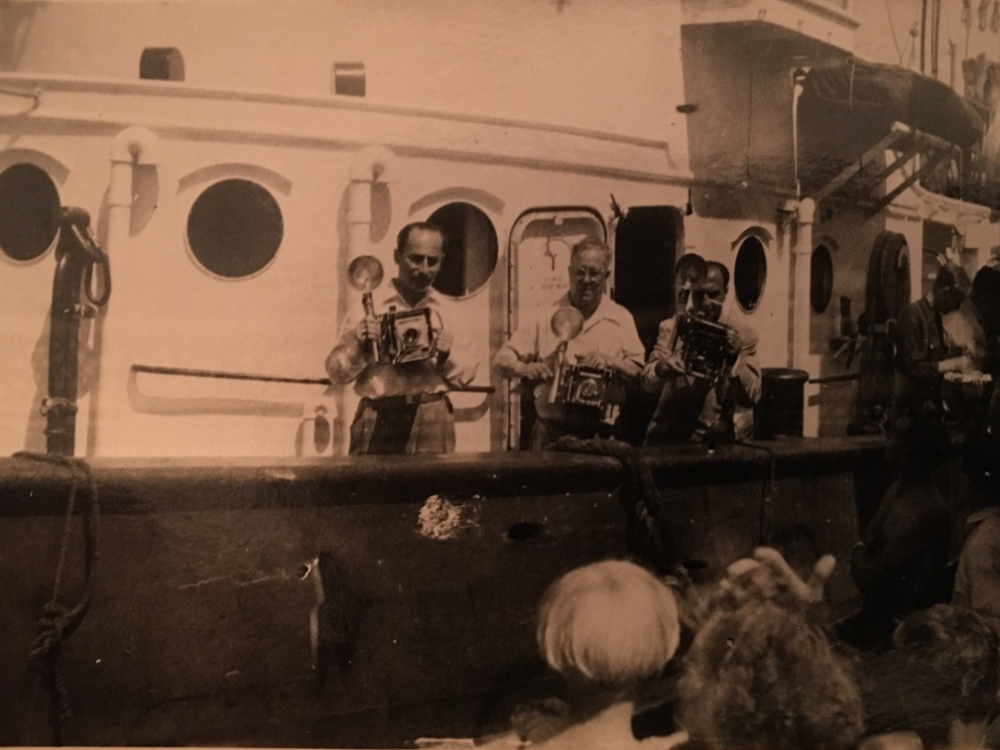Boats

Refugees on board the Skagen.
Skagen
In 1949, 15 Latvians pooled two years of savings and bought the Skagen, a rusty, 119-foot-long (36.3 meter), 219-ton German fishing trawler. The 45-year-old boat cost 35,000 Swedish kronor. Andrejs Osis, a Latvian, was hired as captain.
The Skagen was designed to accommodate 30 people, including the crew, but the new owners rebuilt the freight space to fit 84 people in tiers of triple-stacked sleeping bunks. The steam engine and coal bunkers occupied the rest of the boat. There were 64 Latvians, 16 Estonians, two Poles, a Lithuanian, and a Norwegian. Passage cost 900 kronor for adults (44 men and 25 women) and 200 kronor for the 15 children on board.

Passenger Aleksanders Grinups (left), a medical doctor, spoke English and interpreted for Captain Andrejs Osis after the Skagen docked in Boston.
“The Baltic Sea has become a prison sea. Everywhere the Reds have locked the door, even watching the Kattegat. You slip through at night. Even the Swedes are locked in a prison. We couldn’t stay because freedom means too much to us to give up without a struggle.”
Captain Andrejs Osis, Boston Post, July 6, 1949
“In Sweden they were good to us but you understand how Russia threatens. If Russia demanded us from Sweden what could Sweden do?”
Skagen passenger Aleksei Valm, Boston Post, July 6, 1949
Passenger Maimu Reinla escaped from Pärnu, Estonia, with her husband and daughter, on September 21, 1944. They headed to the Estonian island of Kihnu and then boarded the yacht Viru, arriving in Gotland, Sweden, on September 25. The family moved to Halmstad, Sweden, where Maimu worked in a felt factory until they understood they had to flee once again.
In her memoir, Mrs. Reinla recalled that the Swedish Port Authority did not permit the Skagen to carry more than 30 people, so 54 passengers chartered the smaller Brilliant to connect them with the Skagen, which was waiting in open waters outside Göteborg. A fierce storm almost scuttled the Brilliant but eventually the passengers boarded the Skagen on June 9, 1945. The boat sailed through the English Channel and reached Cork, Ireland, on June 16, where the crew bought water and 120 tons of coal. Reinla recalled that the Irish were “poor looking” but “seemed very happy and were kind to us.”

Boston Evening American, July 6, 1949
On June 18, 1949, the Skagen left Ireland for Canada. Captain Osis was forced to change course through the Azores to avoid a storm, which added five days to the journey. “All the way across we lived on soup,” Alfreds Ozolins, the cook, later told a reporter for the Boston Evening American. “Soup for breakfast, dinner, and supper. Except the babies, we had canned milk and white bread for them. But it was all gone when we got [to Boston]. And our water almost gone, too.”
During the final three days of the trip, the steam engine’s fresh water supply ran out and the crew had to use salt water. There was one day left of coal when the Skagen arrived unannounced in Boston, Massachusetts, on July 5, 1949, flying the red and white flag of independent Latvia. Although the crew originally planned to sail to Canada, they ended their journey in Boston, in part because the Gundel, another Viking boat, had landed there a year earlier.
“You ask why we came to America? I will tell you why. America has the greatest freedom. America is the only country to have a chance to defend itself against Russia.”
Alfred Ozolins in the Boston Evening American, July 6, 1949
Since none of the passengers had visas, they were taken to East Boston detention station and waited for several months before receiving permission to stay in America. The Reinla family settled in Connecticut.

Act of May 29, 1952, recognizing refugees as Displaced Persons eligible to apply for admission to the United States. The Reinla family is underlined.
Known crew and passengers:
- Captain Andrejs Osis, 36, and father, Karlis Osis, 54
- Alfreds Ozolins
- Aleksanders Grinups
- Mihkel, Maimu, and Õie-Ingrid Reinla, 4
- Karl, Laine, and Harry Peet, 2
- Rudolf and Johanna Kermon
- Mihkel, Anna, Arno, 9, and Inga-Mai Vesik
- Karli Salm
- Mihkel Valm, Aleksei and Theodor Valm
- Alfreds Butlers
- Juozas Grigutis (Lithuanian)
- Marian Bierman, Edward Zbigniew Bierman (Polish)
- Waylett Olsen (Norwegian)
- Alfreds, Zenta-Lilija, Elite, Silvija-Anite Dzerve
- Arturs, Vaalija, Ausma, Ilgvars, Aris, Vilnis, Janis Svede
- Antons Sumskis
- Laura, Ivars Apse
- Valija Bindermanis
- Arthurs, Anete Ermansons
- Karlis Sturmanis
- Harijs, Andrejs, Alide, Lilija, Benita Sicevs
- Emma, Alberts Langsbergs
- Ella, Vilis Dankers
- Teodors, Anna Freimanis
- Marta Akmans
- Valdis Landmanis
- Janis Liepa
- Janis Zieds Kalupnieks
- Arvids Berzins

A boat filled with reporters approached the Skagen in Boston harbor.
- Jekabs, Vilnis, Milda Snikers
- Janis Iesalnieks
- Talivaldis Veinbergs
- Imants Fridmanis
- Aija Upite
- Alfreds, Anna, Taiga Butlers
- Karlis Strelcs
- Janis Freienbergs
- Visvaldis Dzintarnieks
- Augusts, Krists Stenclavs
- Pauls, Mirdza, Rita Kurcbaums, 5 months
- Karlis, Emma, Andrejs, Lisa Osis
- Martins Arvids Innus
- Haralds Zarins
- Valdis Feimanis
- Fricis, Zenta Paipals
- Eberhards Oskars Cesnieks
Photographs by Mihkel Reinla, courtesy of Jon Mihkels.
